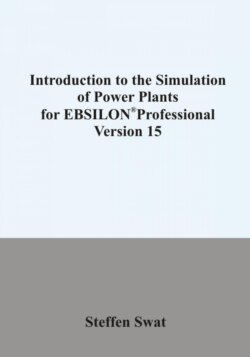Читать книгу Introduction to the simulation of power plants for EBSILON®Professional Version 15 - Steffen Swat - Страница 3
3 Creating a thermal cycle diagram 3.1 Start of a cycle diagram
ОглавлениеTo start the program EBSILON the following steps have to be carried out:
1 Click on the Windows “Start” menu.
2 Select the folder EBSILON
3 Click on “EBSILONProfessional 15 64 Bit” or “ EBSILONProfessional 15 32 Bit”If you have newer patches, P1 may have been added to the version number, for example.(Alternatively you can place or use the icon for the shortcut on the desktop.)
After the program has finished starting, you should have the program interface as shown in Figure 4. If you would like to change the language settings at the beginning, you can open the “General Options...” window via the Tools menu item and then make a change under “International Settings” in the “Language” selection window (Figure 3). Directly below the language setting, there is another selection window with which you can choose which system of units should be used by EBSILON. This selection should be set to "according to default value" or "SI units".
Figure 3: Language and unit settings
Then create a file with your name. Proceed as follows: Select the field “File” from the menu bar. Then go to “Save as...” and search for a suitable target directory (preferably on your USB stick). Save your file, indicating it with your name.
Then you should create a text field in which you can enter your name and a description of the circuit diagram (e.g. the plant name). In order not to hinder the further process, the text field should be created in the upper left corner. Click on the “Text” icon in the component bar. To position the text field on the workspace, click anywhere and drag the mouse cursor, holding down the left mouse button, a little to the right to insert the text field. Release the left mouse button to end the process. The word "Text object" should appear in the text field that has just been created. Since only one text field is to be created, click once with the right mouse button to end the selection. If you would not end the action, a new, additional text field would be inserted in the work area each time you click the left mouse button again.
To edit the resulting text field, right-click it and select the Properties menu item. Alternatively, you can select the text field by double-clicking it. In the opened window, enter your name and the task name in the text field as shown in Figure 4. In the tab “Format”, you can make settings regarding font, font style and font size. Go to the tab Format and set the selection field for auto scaling to "None". You can then adjust the font size so that the text field appears appropriately large on the workspace (Figure 5). A font size of 16 is best. Finish this step and close the window. If the text you have entered is now showed incompletely, you can use the black markers to enlarge or reduce the text field.
Figure 4: Editing the text field
Figure 5: Text field on the desktop
For the further procedure it may be convenient to make some settings in the view menu. The menu bar contains the sub-item “View”. Here you can make various settings that change the appearance and functionality of the work area and work bars. In the upper area of the menu you have the possibility to activate or deactivate different bars. For example, if you remove the check mark for “Zoom bar”, it disappears from the work area. Now click on “View” and select the item “Grid lines”. Now a grid appears in the work area, which can help you to orientate yourself on the work surface. You can switch this grid on and off in this way, this process does not affect the placed objects. With the submenu item “Background colour...”, you can set the colour of the working area in the view menu.
